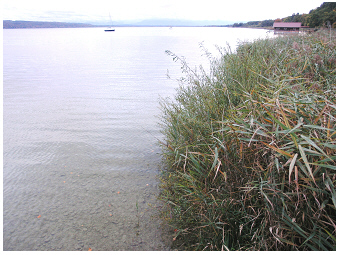About Ammersee:
The lake is in synchrony with other
lakes
geographical location of the lake in the bavarian alps
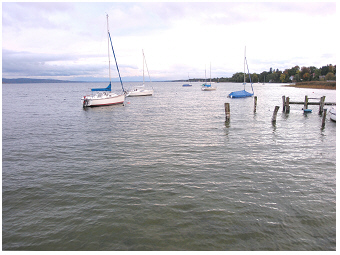 Lake Ammeree, 2012:
Lake Ammeree, 2012:
View from the
west-shore, in Schondorf, in south direction onto the lake basin.
Despite the habor a reed belt is still common as seen in the background
west-shore of the lake.
Lake Ammersee (48°00’34.5''N,
11°7’2.4''E)
is a pre-alpine lake at
523.9 m above
sea level
in Upper
Bavaria (Germany),
about 50 km distant from Munich.
The lake is one of the sixth largest lakes in Germany, has a
water
volume of 1750 x 106 m3,
an area of 46.61 km2 and a maximum
depth of 81 m.
The water retention time is 2.7 years (Table 1
in Dokulil et
al.
2006 R).
The nutrient situation for lake Ammersee can be described as
mesotrophic. This means, that the nutrient
concentrations in the water body, mainly of phosphorus, are slightly
higher than it can be expected from the natural
nutrient-poor background of pre-alpine lakes. The littoral stands of
the
plant Phragmites australis
extend over large sections on the shoreline of lake Ammersee. Such wide
intact
reed belts are
still common for lake Ammersee. In this view lake Ammersee is quiet
different from lake Mondsee (see paragraph about the
macrophytes on the
website
Mondsee S)
 Lake Ammersee, 2012:
Lake Ammersee, 2012:
Littoral stands of Phragmites
australis build mainly the reed belt on the
west-shore.
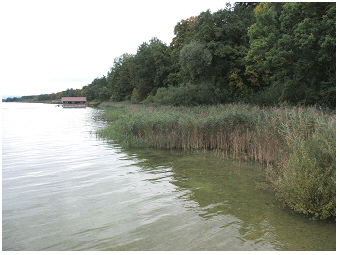 Lake Ammersee, 2012:
Lake Ammersee, 2012:
View onto the reed belt on the
west shore.
As claimed for the alpine lakes in the Salzkammergut district in Austria (see on this website about alpine lake Attersee S), also lake Ammersee takes advantage from low-nutrition in the alpine catchment, is benefiting from sustainable agriculture and sewage-treatment plants in the Bavarian Alps in Germany.
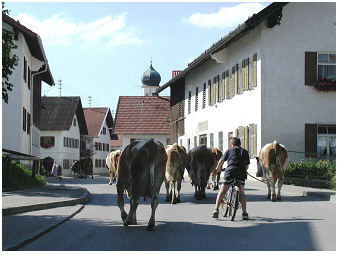 Catchment of lake
Ammersee, 2002:
Catchment of lake
Ammersee, 2002:
Sustainable dairy cow farming in lower valleys. The photo is taken in
Haunshofen (Weilheim-Schongau district).
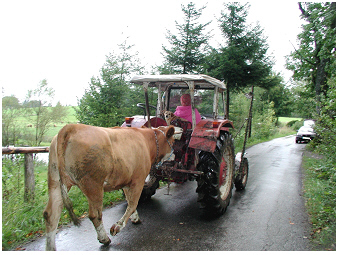 Catchment of lake Ammersee, 2002:
Catchment of lake Ammersee, 2002:
Traditional animal husbandry; Livestock is grazed in low valleys during
growing season.
deepwater warming and climate response of lake ammersee shows a particular close regional synchrony with lakes of the western alps
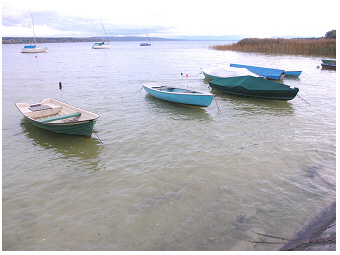 Lake Ammersee, 2012:
Lake Ammersee, 2012:
View from northern part of
the west shore in south direction onto the lake.
The coherence,
i.e.
the synchrony, between lakes can be analysed by the
correlation between time-series of lake-data over a same certain time
period. As climate is global and may affect regional weather conditions
in many places, an unusual warm or cold winter-spring period will
certainly not only affect a single lake but many lakes over longer
distances across Europe at the same time. As mentioned for Mondsee,
coherence is best seen for the over-all lake physics as e.g. water
temperature than for lake-specific issues, as e.g. catchment dependent
chemistry, human impacted nutrient availability or biology.
A synchrony of deepwater temperature was indeed found between 12
studied lakes across Europe, from Sweden, United Kingdom, Germany,
Austria, Switzerland and France (Fig.2
in Dokulil et
al.
2006 R).
The deepwater
temperatures of the hypolimnion varied from year to year
but increased in
all these lakes by about
0.1–0.2°C per decade (Figs.2&4,
Table 4 in Dokulil et
al.
2006 R).
The most consistent predictor of
hypolimnetic temperatures was seen in the climate signal of the
North Atlantic
Oscillation (specifically the mean NAO index for
January–May), which explained 22-63 % of the interannual
variation of
lake temperatures in 10 of 12 the lakes (exceptions were two remote
lakes in less wind-exposed alpine valleys; lake Walensee and lake
Hallstätter See). Lake Ammersee shown in this study has the closest
deepwater synchrony to four lakes in the western Alps, i.e. to Lake
Geneva, Zürichsee, Walensee and lake Constance, than to lakes
elsewhere.
ammersee and mondsee: two lakes but one story
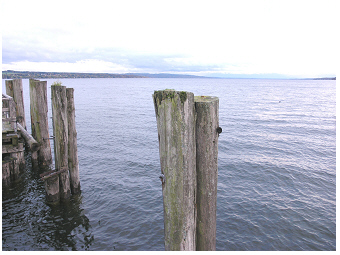 Lake Ammersee, 2012:
Lake Ammersee, 2012:
View from northern part of
the west shore in south direction onto the lake.
Lake
Ammersee is about 200 km
away from lake , with a catchment area that is
about four times larger than of
Mondsee S.
The lake basin
of Ammersee is
about 10m deeper and has a three times larger water volume and water
surface, respectively, than Mondsee. The water retention time is
accordingly more extended than for Mondsee, namely 1 year
longer (2.7 years). Both lakes are mesotrophic.
The section before described the synchrony of deep water warming trends
in various lakes across Europe. The temporal coherence of water surface
temperature trends between neighbouring lakes, however, can be even
stronger. Therefore, despite the rather weak coherence of deepwater
warming in Ammersee and Mondsee, an indeed significant strong synchrony in particular for water
surface temperature, but also for some parameters
describing the whole water body seasonality was found. Very similar to
Mondsee S
, the time lag between the annual peak of total incoming
radiation and air temperature is 32 days, the surface water
temperature
42 days, the thermal stability of water column calculated as
Schmidt
stability 45 days and the heat content of the whole water body of lake
Mondsee 54 days, respectively. As in Mondsee, the timing of the annual
maximum of these temperature related parameters and the spring peak of
phytoplankton tend to pass earlier the year (study period 1985-2001).
Phytoplankton composition in Ammersee is similar to that of Mondsee as both alpine lakes passed years of eutrophication before restoration, mainly achieved by sewage treatment in the catchment, which turned the lake to a reoligotrophication period. As in Mondsee, the cyanobacterium Planktothrix rubescens contributed mostly to phytoplankton biovolume and formed a pronounced deep chlorophyll maximum (DCM) at the layer from 7-12 m (Fig.2i in Teubner et al. 2003 R, Figs.11&28 in Teubner et al. 2004 R, Fig.1 in Teubner et al. 2006 R). The chlorophyll-a concentration of the deep layer was at that study period 1998-2001 significantly higher than of the epilimnion in Ammersee, which was a situation typically also found in Mondsee and hence already discussed there in greater detail.
P. rubescens stratified most frequently at the meta- to hypolimnetic depth layer of 0.91 %surface light intensity in Ammersee, while the epilimnetic phytoplankton formed preferentially the main biomass peak at 11.9 % light intensity (study period 1998-2001, Figs. 28 & 30 in Teubner et al. 2004 R, Fig.1 in Teubner et al. 2006 R). Other algae, which also built their biomass mainly in the deep layer and were hence associated with P. rubescens were diatoms as Asterionella formosa and flagellates as Katablepharis ovalis, Gymnodinium helveticum and Woloszinskia/Peridiniopsis (detailed study in 2001, see microphotographs & Fig.2 in Teubner et al. 2003 R ). This vertical pattern also became evident from the deep maxima of marker pigments, specifically for the cyanobacterium P. rubescens (oscillaxanthin) and for cyanobacteria in general (myxoxanthophyll, zeaxanthin and xanthaxanthin), further for diatoms (fucoxanthin) and cryptophyceans (photosynthetic alpha-carotene; depth distribution of pigments in Fig.3 in Teubner et al. 2003 R). In total more than 40% of 83 observed taxa were flagellates in alpine Ammersee (Teubner et al. 2003 R). Besides the afore mentioned deep-living flagellates, some flagellates were found to be more abundant in the euphotic layer 0-7 m than in deeper strata such as Chrysochromulina parva, Cryptomonas erosa, Pseudokephyrion entzii, Rhodomonas lens, R. minuta and Ceratium hirundinella (Fig.2 in Teubner et al. 2003 R). Such pattern of vertical separation of phytoplankton species and their marker pigments described here for Ammersee was, in principle, also found for lake Mondsee (Teubner & Greisberger 2007 R, Dokulil & Teubner 2012 R).
Identifying steady-state phytoplankton assemblages in Ammersee, three spatially heterogeneous environments for vertical niche separation were compared within the top 12 m: the euphotic epilimnion (2 and 5 m), the euphotic metalimnion (7 m) and the metalimnion below the euphotic zone with dim-light less than 1% light from the water surface (10 and 12 m) in Ammersee. The deep living phytoplankton assemblage at the dim-light level below 1 % light intensity can be described as a rather persistent community (Fig.5 in Teubner et al. 2003 R). The species composition reached here more than 80 % similarity between successive monthly samples, associated with almost zero net-change rates of phytoplankton biovolume (Fig.7 in Teubner et al. 2003 R). The deep-layer phytoplankton data points cover a hump-shaped curve, with net-change rates plotted on the x-axes and similarity on the f(x)-axis. The similarity of phytoplankton composition between successive monthly samples in the euphotic layers (2, 5 and 7 m) never reached more than 60 % and was usually significantly lower, even if biovolume net change was around zero. From this observation, it could be concluded that only during stratification and only in the metalimnion below the euphotic zone steady state assemblages can be expected in the deep mesotrophic Ammersee. Such a detailed analysis of species shifts along depths was not conducted for lake Mondsee, but an overwhelming biomass of P. rubescens persistent in deep strata, and a more frequent phytoplankton species shift in near surface strata was also found in Mondsee (Dokulil & Teubner 2012 R).
To sum up here, the two alpine lakes 200 km apart, Mondsee and Ammersee, are in view of general lake phenology, eutrophication history and phytoplankton composition rather similar than different.
cited References: about ammersee
Dokulil M, Teubner K (2012) Deep living Planktothrix rubescens modulated by environmental constraints and climate forcing. Hydrobiologia, 698:29–46 DOI:10.1007/s10750-012-1020-5 OpenAccess
Greisberger, S. & K. Teubner. 2007. Does pigment composition reflect phytoplankton community structure in differing temperature and light conditions in a deep alpine lake? An approach using HPLC and delayed fluorescence (DF) techniques. J Phycol, 43, 1108-19. doi:10.1111/j.1529-8817.2007.00404.x Look-Inside FurtherLink
Dokulil MT, Jagsch A, George GD, Anneville O, Jankowski T, Wahl B, Lenhart B, Blenckner T, Teubner K (2006) Twenty years of spatially coherent deep-water warming in lakes across Europe related to North-Atlantic Oscillation. Limnol Oceanogr, 51 (6):2787–2793 DOI:10.4319/lo.2006.51.6.2787 OpenAccess
Teubner, K., Tolotti, M., Greisberger, S., Morscheid, H., Dokulil, M.T. & V. Kucklentz. 2006. Steady state of phytoplankton and implications for climatic changes in a deep pre-alpine lake: epilimnetic versus metalimnetic assemblages. Verh int Limnol 29: 1688-1692. Look-Inside
Teubner, K.. 2006. Ergebnisse des Forschungsvorhabens „Bedingungen für das Auftreten toxinbildender Cyanobakterien (Blaualgen) in bayerischen Seen und anderen stehenden Gewässern." In: Toxinbildende Cyanobakterien (Blaualgen) in bayerischen Gewässern: Massenentwicklungen, Gefährdungspotential, wasserwirtschaftlicher Bezug. ed Ha Morscheid. Bayerisches Landesamt für Wasserwirtschaft Materialienband Nr. 125: p.49-74, München. ISBN: 13: 978-3-940009-08-1 Look-Inside OpenAccess / OpenAccess
Teubner, K., Morscheid, Ha., Tolotti, M., Morscheid, Hei. & V. Kucklentz. 2004. Bedingungen für das Auftreten toxinbildender Blaualgen in bayerischen Seen und anderen stehenden Gewässern. Bayerisches Landesamt für Wasserwirtschaft Materialien Nr. 113: 1–105, München. Look-Inside OpenAccess
Teubner K, Tolotti M, Greisberger S, Morscheid H, Dokulil MT, Morscheid H (2003) Steady state phytoplankton in a deep pre-alpine lake: Species and pigments of epilimnetic versus metalimnetic assemblages. Hydrobiologia 502:49–64 DOI:10.1007/978-94-017-2666-5_5 Look-Inside FurtherLink
Dokulil, M.T. & K. Teubner. 2002. The spatial coherence of alpine lakes. Verhandlungen der Internationalen Vereinigung für Theoretische und Angewandte Limnologie (Verh. Internat. Verein. Limnol.) 28: 1-4. Look-Inside
Teubner, K. 2001. Algengemeinschaften in Seen. 83-112. In: Ökologie und Schutz von Seen. UTB Facultas, Wien. Look-Inside
Dokulil, M. & K. Teubner. 2000. Cyanobacterial dominance in lakes. Hydrobiologia 438: 1-12. Abstract FurtherLink
